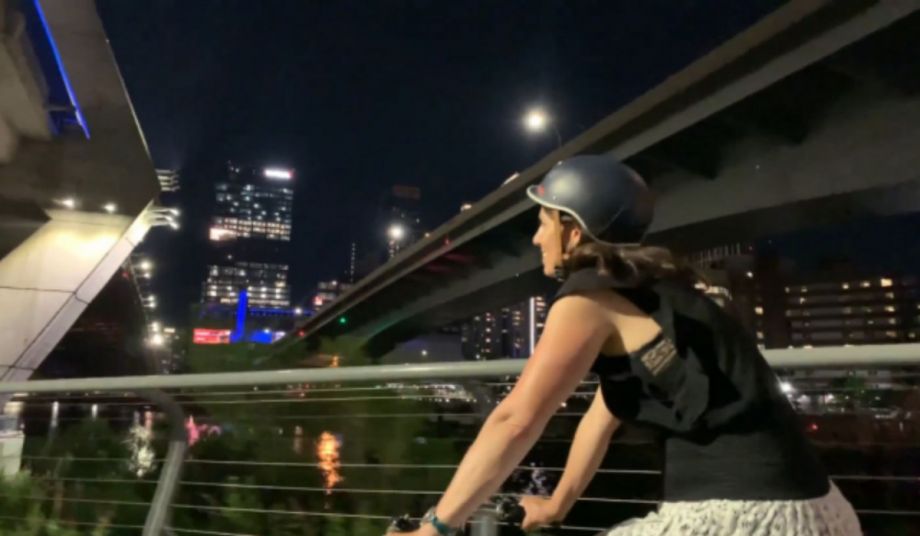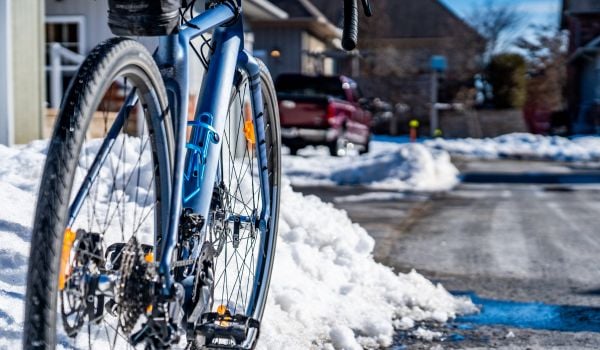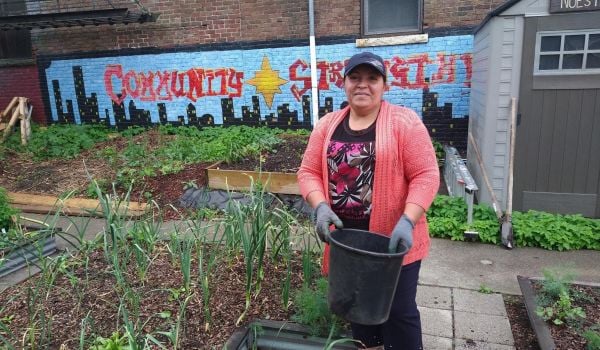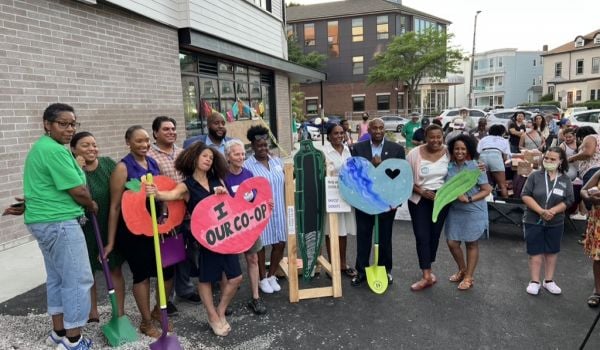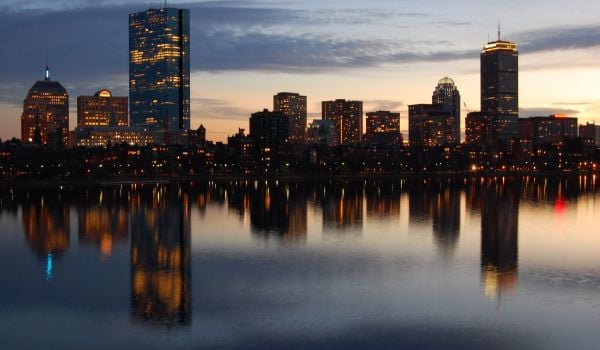As Vivian Ortiz rides along Boston’s Southwest Corridor bike path, her bright yellow high-viz vest flaps gently behind her. It’s well past dark, and in the brief moments between the street lamps, her bike lights illuminate the path ahead.
“I absolutely love riding at night,” she told me from her home in Mattapan, where her bike helmet is visible on a shelf behind her desk.
Ortiz is one of the seven women featured in “Women Who Bike at Night,” a new documentary project that explores why and how Boston women ride after dark.
For Ortiz, that journey began eight years ago when she took a biking clinic for women through the city of Boston. The session got her hooked, but she was most comfortable in group rides with their strength in numbers. Biking busier roads like Blue Hill Avenue, a hilly main thoroughfare in her Mattapan neighborhood, felt especially daunting. A friend encouraged her to join him for nighttime rides when the city streets were quieter.
“It was so relaxing and so refreshing and not stressful because there were less cars,” she said. “I really enjoyed it. And I never worried honestly about the public safety of it, because we were just out enjoying the evening.”
That feeling — of biking at night as an enjoyable freedom — is a recurring theme across the documentary. It’s one that creator Grecia White relates to as well. She was finishing her master’s in urban informatics at Northeastern University when the pandemic hit and she started riding around Boston at night as a way to decompress.
“As I talked to friends about it, some of them expressed concern over safety issues, which I did not [have],” she said. “It was more of a, ‘no, this is really fun.”
As she got more into night riding, she started looking for videos and other representation online for women biking at night. She came across plenty of clips of men but none of women.
“I saw it as a gap in what stories are out there,” she said. “It’s not that women aren’t doing it — they are — it’s just that we aren’t hearing about it.”
She put out a call for women in the Boston area who rode at night. She worked on the project in tandem with her research on public transit through a gender lens, studying perceived safety at bus stops after sunset.
While the people featured in “Women Who Bike at Night,” have already embraced after-hours riding, Boston city planners are also working to expand who feels comfortable biking in the dark.
Stefanie Seskin, the city’s active transportation director, is a woman who bikes. To understand what city residents need, she spends “a lot of time listening to other people and their perspectives.”
“I’m a white woman,” she said, “but things might be different for someone who is Black, who wears a headscarf, who is of a different body type.”
One of her current projects is a new bike trail that will link the Roxbury, South End and South Boston neighborhoods. Parts of the trail run through industrial areas and under a highway overpass. Seskin highlighted ways the city plans to make the path more usable after dark, like a separated bike lane better protected from cars and bright lighting. In addition to the road safety factor, there’s also the personal safety factor: making sure the path wasn’t isolated from the city fabric and other people for too long.
“It’s about making sure the bike facilities are safe, that they’re designed well, so you can relax into them,” she said. “There is a different perspective that people have in space based on how they identify and how that changes over time — both as you age, but also throughout the day.”
Although the specifics will vary, these are common elements for accessible and safe night biking, says Andreina Seijas, a senior consultant for an urban planning firm in Barcelona. Seijas studied nighttime governance at the Harvard Graduate School of Design and rode at night while living in Cambridge. She cites “hardware” — infrastructure like protected and separated bike lanes, lighting and bike racks at destinations — as well as “software” — city regulations, cultural mores and perceived safety — that can make riding at night accessible to more people. Getting there requires acknowledging that the night is different.
“The night is a blind spot for urbanists,” Seijas said. “It’s a blind spot for politicians. Sometimes they forget that there’s a bunch of people who are living out there who are commuting or trying to commute. I think from a perspective of quality and inclusion, you need to consider these people when you’re planning.”
Many of the women featured in “Women Who Bike at Night” use a bike as their primary mode of transit. Riding at night is part of the package: Especially during Boston winter, when the sun starts setting as early as 3:30 p.m., biking for transportation means riding at night. And some night riding is driven by need: Anyone without a car in Boston working a shift at a bar or hospital or warehouse that ends at 3 a.m., has limited options for getting home. Boston’s public transit system mostly shuts down around 1 a.m., with a handful of bus routes running overnight service. Ortiz often hands out lights to bikers working for food delivery companies that didn’t provide their employees proper gear.
Overall, biking is on the rise in Boston. Over the past 20 years, the percent of people in Boston biking for their commute has increased 59%. Cambridge and Somerville, linked to Boston’s bike networks on the other side of the Charles River, both are in the top 15 U.S. cities with the most bike commuters. In 2020, Boston put in more bike infrastructure than any year previously, according to Seskin. That year, bicyclists made up more than 9% of all evening commuters during Boston’s June and September bike counts — an even higher share than the morning commute.
But these numbers don’t fully explain why people choose to ride — or not ride — after sunset.
“You can have access to all the graphs in the world but still change doesn’t happen,” White said. “But if you see a story, it can resonate more or complement the quantitative data.”
And seeing a story can come through a film or in your neighborhood: Ortiz has been a spokesmodel for the city’s “I Bike Boston” campaign. She recently became Boston’s first Bike Mayor, joining a network of local cycling advocates organized by the global bike nonprofit BYCS. In April, she’ll resume leading an all-levels ride along the Neponset River Greenway in Mattapan with a focus on building community and providing a space for Black, Latina and older women to bike. For many months of the year, it’s dark when they ride home.
“I just want to normalize this,” White said. “If biking at night has been something that you’ve been curious about or you’ve wanted to try then it’s meant to provide some kind of support. There’s no one type of person that is getting on their bike at night.”
“Women Who Bike at Night” will be available on Vimeo March 1.
Editor’s Note: Grecia White’s master’s degree from Northeastern University was corrected to urban informatics.

Ashira Morris is a freelance reporter based between Sofia, Bulgaria, and Tallahassee, Florida. Her work, focused on local environments and the forces that shape them, has been published by National Geographic, Foreign Policy, and the Guardian.

